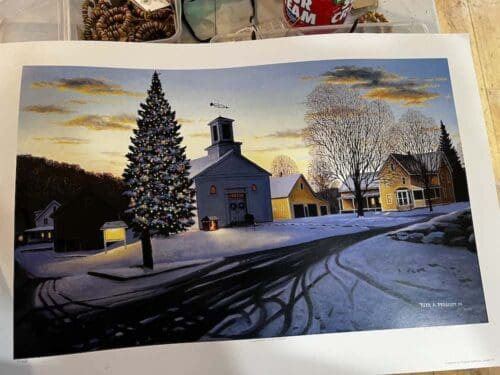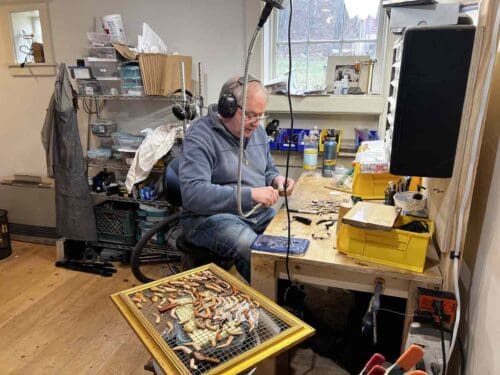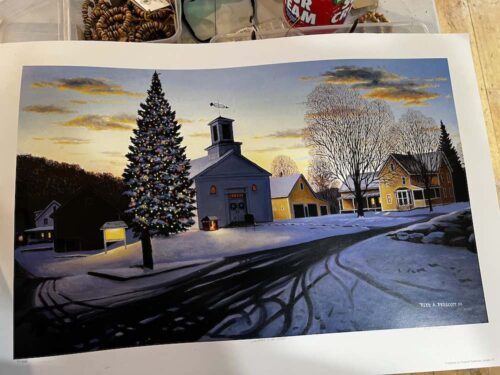
Reed Prescott is an award-winning artist, living and working next to the General Store in Lincoln, Vermont.
Born in nearby Saint Albans, Prescott spent much of his youth following his father across the country from military base to military base. Prescott’s mother brought her kids back to Vermont when his father was sent to Taiwan during the Vietnam War.
While staying with his aunt, Prescott picked up a book titled Learn to Draw by Jon Gnagy. The eight-year-old was instantly hooked.
Prescott recalled: “Learning to draw was great for a young boy. With my dad in the military, we traveled by car from base to base. I sat in the back of the car sketching away, capturing the landscapes and passing the time on those long drives.”
After drawing for so long and having other people tell him how good he was at it, Prescott decided to pursue an art career. He enrolled in the art school in Worcester, Massachusetts, where he learned the intricate details of capturing light and conveying stories. While he started making a transition to oils, Prescott continued his sketches.
His first big break came when he was hired by Ron Rood to illustrate a nature book. Even though he did not have a portfolio, Rood asked him to sketch a few nature drawings and submit them. Prescott did, and he was hired immediately.
The contract called for Prescott to deliver 105 drawings in 45 days. He was elated until he went to the library to do some research. Most nature books had anywhere from 20 to 30 drawings. He put his head in his hands and wept. What had he done?
Fortunately, Prescott quickly developed a schedule, creating three drawings daily, five days a week. Unbelievably, he completed 95 drawings by the deadline only to be told that he could take his time because the publisher would not hit their publication date.
Prescott said he learned several lessons from that experience that stuck with him his entire career. The project revealed a four-stage process to his art: (1) He always over-commits, (2) he cries, (3) he prays, and (4) he rolls up his sleeves to meet his deadlines.
While relinquishing his creative stages can be a complicated process, Prescott said that he has learned to embrace it as part of his creative journey. His art is better because of the process.
(Photo: Mitch Randall)
Illustrating books led to other opportunities, such as working at galleries and continuing his career as a nature artist. He won awards for his drawings of ducks and other wildlife, but he started getting interested in capturing local scenes that told a story. So, he started to paint landscapes.
Many of his friends discouraged him from painting landscapes, declaring that his wildlife work was the best they had ever seen. However, when one of his friends saw a final version of one of his first landscapes, they quickly changed their minds, commenting, “You have to abandon wildlife and start painting landscapes.”
After making the switch, Prescott started traveling to nearby Basin Harbor Resort to paint. He laughed at all the stories he could tell about people watching him paint.
One of his favorite things to do was to allow children to help him. He would mix up some green and let them make some strokes on the canvas, helping him create grass. They loved it, and their parents would buy the painting nine out of 10 times. He declared himself a marketing genius.
Twin boys were watching him paint once when he decided to let them contribute some grass. Their mother walked up, watching her two little ones have the time of their lives.
In his peripheral vision, he noticed another man walk up. Taking a closer look, he was astonished to see that it was musician James Taylor. Prescott had unknowingly given the brushes to Taylor’s twin sons.
Prescott’s career was steady, even though he remained a struggling artist financially. His landscapes garnered more attention as his talents and skills continued to prosper. Unfortunately, his career as a landscape artist was about to be over.
For a few years, Prescott had what he called “white-outs,” with his vision going white and him waking up on the floor. He kept insisting to the doctors there was something wrong, but they kept ignoring his pleas. They told him he sat up too fast or got overheated, but he knew there was something more at stake.
Prescott passed out again on one occasion and was rushed to the emergency room. While at the hospital, his heart stopped for 23 seconds, forcing the doctors to insert a pacemaker. When he woke, he looked at the doctors and asked, “Now do you believe me?”
After the event, Prescott noticed he struggled with painting. His vision was so bad he would get physically sick after about an hour or so at the canvass.
After evaluating his condition, physicians determined he had visual vertigo. His eyes would never be the same. Most likely, he would never paint again.
For any normal human being, this would be incredibly discouraging. But immediately after setting down the brush, Prescott turned to another medium. He took the news about his deteriorating vision not as a negative but as an opportunity to find something new to learn and master. So, he turned to woodworking.

(Photo: Mitch Randall)
Under the company name “Verde Mountain” on Etsy.com, the one-time painter now creates stunning jewelry, beautiful ornaments and gorgeous light switch covers. Yet, that is just a tiny portion of the story. Verde Mountain’s motto is, “We Create So That Your Memories Live On.”
Prescott started creating his wood art with pieces of lumber he purchased but quickly realized that he would continue telling stories through items meaningful to individuals and communities.
People started giving him pieces of lumber that were meaningful to them, such as field hockey sticks, skateboard decks, baseball bats, hockey sticks, fallen trees on their properties, and other significant lumber with stories to tell.
Prescott takes the wood and creates beautiful pieces for people to cherish. People can wear jewelry or hang an ornament that tells a story. In many cases, the piece reveals a personal story, connecting the wearer with the bracelet, earrings or ornament. It is a fantastic way to continue legacies and share human stories.
On one occasion, a Canadian mother lost her son to death by suicide. She reached out to Prescott, asking if he could make some items from her son’s skateboard deckings. He was honored to do so.
“These items help people remember their loved ones or a special place,” he explained. “They help them hold on while simultaneously carrying their legacies into the future.”
When asked how his faith affects his art and how his art affects his faith, Prescott turned to the mysterious ways of the divine. “As a struggling artist,” he began, “God always provided exactly what we needed when we needed it. When we needed $95 for groceries, someone would walk up to the gallery and buy $95 worth of art. It’s truly amazing how God works.”

(Photo: Mitch Randall)
After contemplating a little, he went further: “But you know, the most fascinating thing to me is how God has taken my work and multiplied it. While at times I think I’m just creating a painting or piece of jewelry, others find peace, comfort and inspiration. Only God can do that for us.”
Leaving the gallery on the day of our interview, Prescott thanked me for telling his story. Like so many in Lincoln, Vermont, the humanity of this community astounds me.
Some might drive through and just see a tiny mountain town beside the New Haven River, but I have been able to see so much more.
Lincoln is filled with remarkable people doing astounding work. Such talented and skillful people live here, creating a community of togetherness.
Their stories need to be told.


